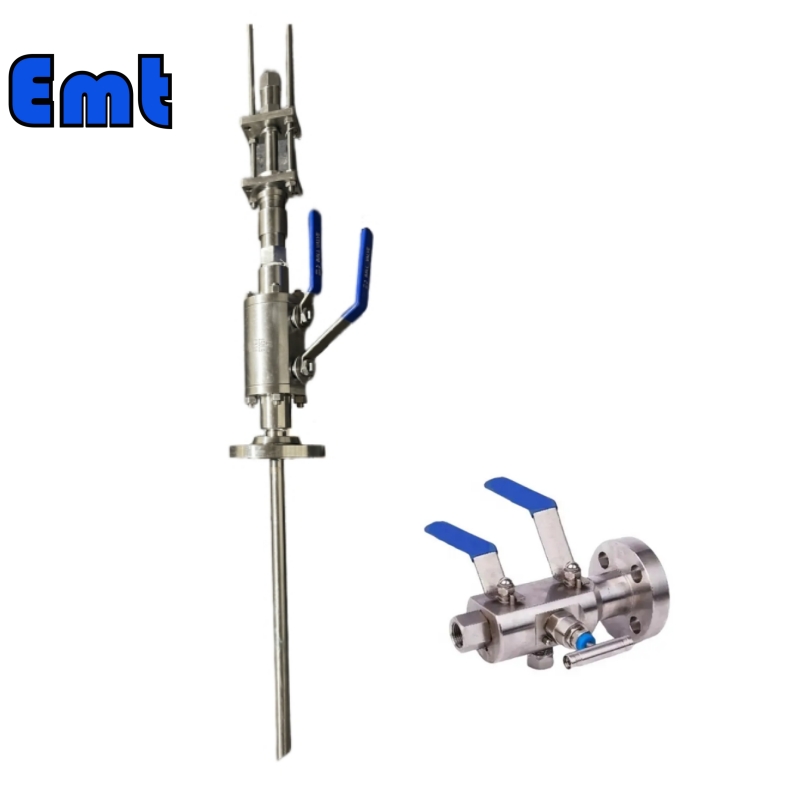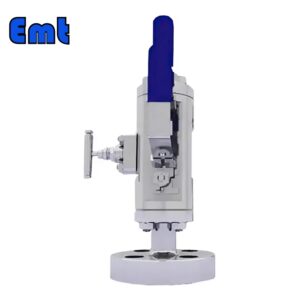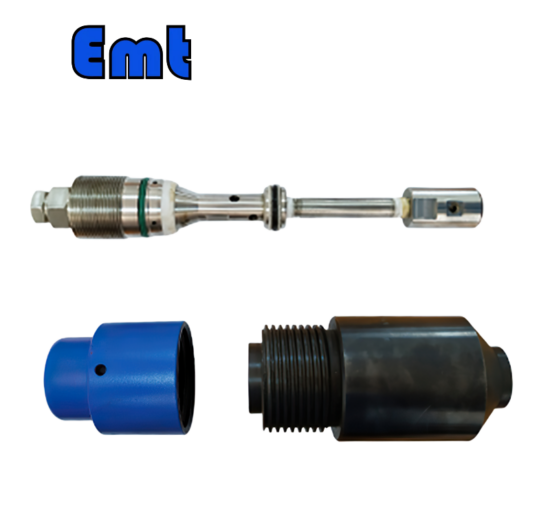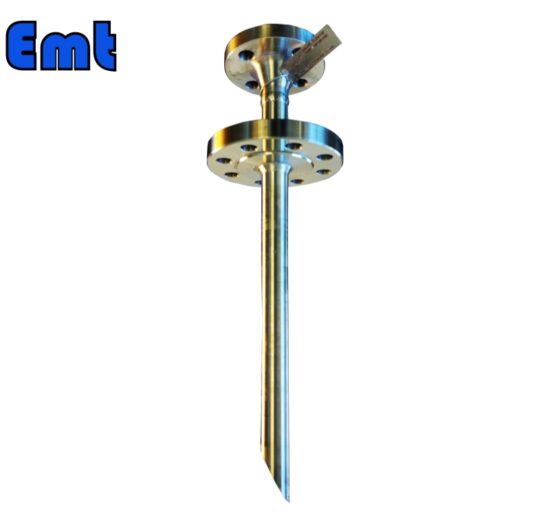Introduction
La plume d’injection chimique EMT combinée à une vanne à double bloc et purge (DBB) représente une avancée significative dans la technologie de traitement des fluides, offrant une solution compacte et efficace pour un dosage précis des produits chimiques tout en garantissant l’intégrité et la sécurité du système.
Dans les applications industrielles modernes, il existe un besoin critique d’injection chimique précise et d’échantillonnage de processus. Ces opérations doivent se dérouler à pleine pression et température de fonctionnement pour maintenir l’intégrité et l’efficacité du système. Des industries telles que le pétrole et le gaz, la pétrochimie et les produits pharmaceutiques nécessitent souvent l’introduction de produits chimiques directement dans le flux de processus. Ces produits chimiques, y compris les agents de déparaffinage, de dégivrage ou de démoussage, aident à maintenir le flux régulier des fluides dans les canalisations.
Dans le même temps, l’échantillonnage du processus joue un rôle essentiel dans le contrôle de la qualité, en veillant à ce que la composition des fluides respecte des spécifications strictes. Les deux activités nécessitent un équipement robuste capable de gérer ces tâches sans compromettre la sécurité ou les performances du système. C’est là que les vannes à double bloc et de purge entrent en jeu. Équipées de piquants d’injection ou de sondes d’échantillonnage, ces vannes offrent une solution compacte et efficace.
Notre société a innové dans ce domaine en proposant des vannes à double bloc et de purge qui intègrent ces fonctionnalités de manière transparente. Qu’ils optent pour un DBB à corps monobloc, un type modulaire, des vannes monobride ou des vannes de collecteur, les utilisateurs peuvent les équiper d’une plume d’injection ou d’une sonde d’échantillonnage. Cette flexibilité leur permet de répondre à des exigences opérationnelles spécifiques tout en maintenant un haut niveau de sécurité et d’efficacité.
Spécifications de la plume d’injection chimique EMT
| Nom | Système d’échantillonnage de piquants d’injection de produits chimiques dans les pipelines |
| Matériel | Acier inoxydable 304, acier inoxydable 316, DSS F51, acier au carbone A105N, Inconel 625 |
| Température de fonctionnement | -20±120 |
| Caractéristique | 1. Utilisation facile |
| 2. Haute précision, longue durée de vie | |
| 3. Haute efficacité, faible coût | |
| Paiement | TT/LC |
| Avantage | Tout d’abord, ils sont légers et flexibles. |
| Deuxièmement, une belle efficacité d’injection. | |
| Enfin un suivi précis de la localisation. |
| Modèle | ||||||||||||||||||||||||||||
| SI | Plume d’injecteur chimique | |||||||||||||||||||||||||||
| -Code | Bouchon | |||||||||||||||||||||||||||
| Pxxx | Type | Matériel | Scellement Matériel | |||||||||||||||||||||||||
| 0 | Aucune demande | 0 | CS | 0 | Aucune demande | |||||||||||||||||||||||
| 1 | Creux Corps de la prise | 1 | 316SS | 3 | DSS | 1 | Joint torique Viton / Garniture primaire en PTFE | |||||||||||||||||||||
| 2 | Corps de prise solide | 2 | 316LSS | 4 | INCONEL | 2 | HNBR | |||||||||||||||||||||
| –Code | Écrou d’injection | |||||||||||||||||||||||||||
| Nxx | Taille de la connexion | Matériel | ||||||||||||||||||||||||||
| 0 | c’est-à-dire aucune demande | 0 | i.e. CS | |||||||||||||||||||||||||
| 1 | c’est-à-dire 1/4" | 1 | c’est-à-dire 316SS | 3 | c’est-à-dire le DSS | |||||||||||||||||||||||
| 2 | c’est-à-dire 1/2" | 2 | c’est-à-dire 316LSS | 4 | c’est-à-dire INCONEL | |||||||||||||||||||||||
| –Code | Injection Tube | |||||||||||||||||||||||||||
| Sxxx-Lx" | Taille de la connexion | Matériel | Buse | Taille de ligne (x") | ||||||||||||||||||||||||
| 0 | Aucune demande | 0 | CS | 0 | c’est-à-dire aucune demande | La position la plus efficace pour l’injection se situe généralement au centre du tuyau | ||||||||||||||||||||||
| 1 | c’est-à-dire 1/4" | 1 | c’est-à-dire 316SS | 1 | c’est-à-dire ouvert | |||||||||||||||||||||||
| 2 | c’est-à-dire 1/2" | 2 | c’est-à-dire 316LSS | 2 | c’est-à-dire Quill | |||||||||||||||||||||||
| 3 | c’est-à-dire le DSS | 3 | i.e. Cap & Core | |||||||||||||||||||||||||
| 4 | c’est-à-dire INCONEL | |||||||||||||||||||||||||||
| –Code | Mamelon et valve (ou extrémité bride) du té | |||||||||||||||||||||||||||
| Txx | Taille de la connexion | Matériel | ||||||||||||||||||||||||||
| 0 | c’est-à-dire aucune demande | 0 | i.e. CS | |||||||||||||||||||||||||
| 1 | c’est-à-dire mamelon de 1/4 po | un | c’est-à-dire mamelon et valve de 1/4 po | 1 | c’est-à-dire 316SS | |||||||||||||||||||||||
| 2 | c’est-à-dire mamelon de 1/2 po | b | c’est-à-dire mamelon et valve de 1/2 po | 2 | c’est-à-dire 316LSS | |||||||||||||||||||||||
| 3 | c’est-à-dire mamelon 3/4" | c | c’est-à-dire mamelon et valve 3/4" | 3 | c’est-à-dire D SS | |||||||||||||||||||||||
| 4 | c’est-à-dire 1" Mamelon | d | c’est-à-dire mamelon et valve de 1 po | 4 | c’est-à-dire INCONEL | |||||||||||||||||||||||
| 5 | c’est-à-dire bride 1/4" | e | c’est-à-dire 1/4" Bride d’extrémité de mamelon | |||||||||||||||||||||||||
| 6 | c’est-à-dire 1/2" Bride | f | c’est-à-dire 1/2 "Bride d’extrémité de mamelon | |||||||||||||||||||||||||
| 7 | c’est-à-dire bride 3/4" | g | c’est-à-dire 3/4 "Bride d’extrémité de mamelon | |||||||||||||||||||||||||
| 8 | c’est-à-dire bride de 1 " | h | c’est-à-dire 1" Bride d’extrémité de mamelon | |||||||||||||||||||||||||
| Par exemple, SI-P221-N12-S122-L4"-T22 | ||||||||||||||||||||||||||||
| SI:e.g. Sampling & Injection Assembly, | ||||||||||||||||||||||||||||
| P221 : par exemple corps de connecteur solide en joint torique Viton 316LSS et garniture primaire en PTFE, | ||||||||||||||||||||||||||||
| N12 : par exemple, la taille de la connexion de l’écrou d’injection est de 1/4 "et Le matériau est 316LSS, | ||||||||||||||||||||||||||||
| S122 :p. ex. injection Tube La taille de la connexion est de 1/4" et Le matériau est 316LSS. Le type de buse est des piquants | ||||||||||||||||||||||||||||
| L4 » :Pour tuyau de 4 ». | ||||||||||||||||||||||||||||
| T22 : Mamelon de la taille de la connexion en T est de 1/2", Le matériau de l’écrou est 316LSS | ||||||||||||||||||||||||||||
Plumes d’injection de la Plume d’injection chimique
Dans de nombreux procédés industriels, l’injection de produits chimiques spécifiques tels que des agents de déparaffinage, de dégivrage ou de démoussage est essentielle. Ces produits chimiques aident à maintenir un flux régulier et efficace des fluides dans les pipelines, évitant ainsi les blocages et maintenant l’intégrité opérationnelle. Par exemple, dans les climats froids, les agents de déglaçage empêchent la formation de glace qui peut obstruer l’écoulement, tandis que les agents de déparaffinage sont cruciaux dans les oléoducs pour dissoudre l’accumulation de paraffine.
Pour injecter efficacement ces produits chimiques, les opérateurs utilisent des vannes à double blocage et de purge équipées de vannes d’isolement primaires et secondaires. Ces vannes jouent un rôle central dans le contrôle du processus d’injection. La vanne d’isolement primaire s’ouvre pour permettre au produit chimique d’entrer dans le flux de processus, tandis que la vanne secondaire offre une couche supplémentaire de contrôle et de sécurité, assurant un dosage précis et empêchant les rejets accidentels.
De plus, ces clapets comprennent souvent des clapets anti-retour. Ces clapets anti-retour font partie intégrante de la prévention du refoulement, garantissant qu’une fois injectés, les produits chimiques ne se retirent pas dans la conduite d’alimentation. Cette caractéristique est cruciale pour maintenir la pureté de la source chimique et la sécurité de l’ensemble du système. Grâce à ces mécanismes, les piquants d’injection assurent l’apport efficace et sûr des produits chimiques nécessaires dans le flux de processus.
Sonde d’échantillonnage
Dans les environnements industriels, la capacité d’échantillonner les fluides de processus avec précision sous la pression maximale du système est cruciale. Cette exigence garantit que la qualité du fluide répond à toutes les normes réglementaires et de sécurité. Un échantillonnage régulier permet aux opérateurs de surveiller et d’ajuster efficacement les processus, tout en maintenant des performances optimales.
Les opérateurs utilisent des sondes d’échantillonnage équipées de vannes d’isolement et de purge pour capturer des échantillons de fluides de processus. Tout d’abord, ils ouvrent la vanne d’isolement primaire pour piéger une quantité spécifique de fluide. Ensuite, ils ferment cette vanne pour isoler l’échantillon dans une section désignée du pipeline. La soupape de purge libère ensuite en toute sécurité l’échantillon piégé à une pression réduite, ce qui le rend sûr pour l’analyse.
Pour des volumes d’échantillons plus importants, l’approche change légèrement. Les opérateurs utilisent toujours les vannes d’isolement primaires et secondaires pour capturer un échantillon plus large. Dans ces cas, l’intégration d’un clapet anti-retour est indispensable. Cette vanne empêche le reflux de l’échantillon dans le flux de traitement principal, garantissant ainsi l’intégrité et l’isolation de l’échantillon. Cette méthode permet non seulement de sécuriser un volume plus important, mais aussi de maintenir la sécurité et la précision nécessaires à une évaluation approfondie. Grâce à ces techniques, les opérateurs peuvent gérer et évaluer efficacement la qualité des fluides de processus.
Clapet anti-retour
Les clapets anti-retour à passage intégral à haute intégrité jouent un rôle essentiel dans la prévention du refoulement des fluides dans les systèmes de traitement. Ces vannes permettent automatiquement au fluide de s’écouler dans une direction et de le bloquer dans la direction opposée. La conception est dotée d’un clapet à ressort qui s’ouvre sous l’effet d’une pression vers l’avant et se ferme hermétiquement lorsque le flux tente de s’inverser. Cette fonctionnalité garantit des performances d’étanchéité essentielles pour maintenir l’intégrité du système et prévenir la contamination.
Les fabricants conçoivent ces vannes avec des pressions de fissuration réglables. Cette caractéristique permet une personnalisation en fonction des exigences de pression spécifiques d’un processus, améliorant ainsi la polyvalence dans différentes applications. La tension du ressort dans le clapet peut être ajustée, ce qui permet de régler la pression à laquelle la vanne commence à s’ouvrir, s’adaptant ainsi à des conditions de fonctionnement variables.
Construction de piquants/sondes
La fabrication de piquants et de sondes offre plusieurs options pour répondre à divers besoins industriels. Une méthode courante est le forgeage monobloc, qui offre une excellente résistance et durabilité en raison de son flux continu de grains de matériau. Alternativement, les producteurs utilisent également des barres forgées, ce qui permet une plus grande flexibilité dans la fabrication.
Les techniques d’assemblage de ces composants comprennent le vissage, le serrage, le soudage à la molette et le soudage par emboîtement. Le vissage et le serrage sont des méthodes simples qui facilitent le montage et le démontage, adaptées aux applications nécessitant un entretien ou des inspections réguliers. Le soudage à la molette offre une résistance accrue et des joints étanches, idéaux pour les scénarios à haute pression. Le soudage par emboîtement assure également une connexion solide et continue, cruciale pour maintenir l’intégrité dans des conditions dynamiques.
Dimension et alésage
La personnalisation est essentielle dans la conception des piquants et des sondes, avec des options disponibles pour la longueur totale de la plume et la nomenclature des tuyaux. Les utilisateurs peuvent spécifier la longueur de la pointe de la plume jusqu’à juste en dessous de la face de la bride, en s’assurant que la plume atteint le flux de processus selon les besoins. La nomenclature des tuyaux, qui indique l’épaisseur de la paroi de la tuyauterie, peut également être adaptée pour répondre aux exigences de pression et de volume de l’application.
Les tailles d’alésage standard comprennent généralement 10 mm, 14 mm et 20 mm, mais les fabricants peuvent fournir d’autres tailles sur demande pour s’adapter à des débits ou des viscosités spécifiques. Cette flexibilité permet d’optimiser la plume ou la sonde en fonction des caractéristiques particulières du fluide de processus et des exigences de la tâche d’échantillonnage ou d’injection.
En proposant ces options personnalisables, des fabricants comme EMT s’assurent que leurs vannes à double bloc et de purge équipées de piquants et de sondes peuvent répondre à un large éventail d’applications industrielles. Qu’il s’agisse d’échantillonnage ou d’injection, ces solutions sur mesure permettent de maintenir l’efficacité opérationnelle, la sécurité et la conformité aux normes de l’industrie.
Conclusion de la pique d’injection chimique
En conclusion, la plume d’injection chimique EMT combinée à une vanne à double blocage et purge (DBB) représente une avancée significative dans la technologie de traitement des fluides, offrant une solution compacte et efficace pour un dosage précis des produits chimiques tout en garantissant l’intégrité et la sécurité du système. Cette intégration permet une injection contrôlée de produits chimiques directement dans le flux de processus, ce qui est essentiel pour maintenir l’efficacité opérationnelle et la conformité dans des industries telles que le pétrole et le gaz ou la pétrochimie.








Il n’y a pas encore d’avis.